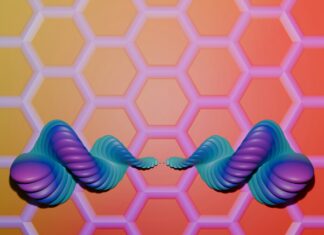Neuroprosthetics: Merging Minds and Machines
In the ever-evolving landscape of medical science and technology, neuroprosthetics stands as a remarkable testament to human ingenuity and our unyielding quest to bridge the gap between disabilities and functional restoration. Neuroprosthetics is a multidisciplinary field that intertwines neuroscience, engineering, and medicine, aimed at developing implantable devices that can replace, augment, or enhance the functionalities of the nervous system. At its core, neuroprosthetics seeks to empower individuals with neurological impairments, such as spinal cord injuries, amputations, or neurodegenerative disorders, by establishing direct communication pathways between the brain and external devices, effectively merging the biological and the artificial.
The human nervous system, with its intricate network of neurons, governs every facet of our physical movements, sensations, and cognitive processes. However, when this delicate balance is disrupted due to injury or disease, the consequences can be profound, leading to loss of motor control, sensory perception, or communication abilities. Neuroprosthetics emerged as a revolutionary concept, promising to restore lost functionalities by creating an interface that translates neural signals into actionable commands for prosthetic limbs, computers, or other assistive devices. This interface often involves the integration of neural electrodes, advanced signal processing algorithms, and machine learning techniques, collectively working towards deciphering the complex language of the brain.
The journey of neuroprosthetics began with a fundamental exploration of the nervous system itself. Researchers delved into the intricate mechanisms that govern how the brain encodes and decodes information, leading to a deeper understanding of how intentions are transformed into actions. This paved the way for the development of neural interfaces that could intercept these intentions, allowing individuals with paralysis or limb loss to control external devices with their thoughts. By implanting arrays of microelectrodes into the brain’s motor cortex, scientists achieved a remarkable feat – enabling paralyzed individuals to manipulate cursors on computer screens or even grasp objects using robotic arms, solely through the power of their minds.
Neuroprosthetics is not limited to motor function restoration; it has also demonstrated the potential to restore sensory experiences. For instance, cochlear implants have transformed the lives of individuals with severe hearing impairment by directly stimulating the auditory nerve, allowing them to perceive sound. Similarly, visual neuroprosthetics aim to restore sight to the blind by incorporating cameras that capture visual information and translating it into patterns of electrical stimulation delivered to the visual cortex. Although these technologies are still in their infancy and face challenges in replicating the complexity of natural sensory perceptions, they offer a glimmer of hope for those who have long navigated a world shrouded in silence or darkness.
Beyond addressing sensory and motor deficits, neuroprosthetics holds promise in deciphering the enigmatic realms of cognition and communication. For individuals with conditions like locked-in syndrome, where the body is immobile but the mind remains conscious, neuroprosthetic devices have the potential to serve as windows to the external world. Electroencephalography (EEG) and functional magnetic resonance imaging (fMRI) have been explored as non-invasive means of decoding a person’s thoughts and intentions. These technologies, when coupled with advanced machine learning algorithms, offer a glimpse into a future where speech synthesis from imagined words and text composition from mere brain patterns could become a reality.
Despite its immense potential, neuroprosthetics faces a myriad of challenges that demand innovative solutions. One of the foremost challenges is achieving long-term stability and biocompatibility of implanted devices. The brain, with its delicate neural structures, does not readily welcome foreign objects, often leading to immune responses or scar tissue formation that can impede signal transmission. Researchers are actively engineering novel materials that not only minimize the body’s reaction but also encourage neural integration over time. Moreover, the sheer complexity of neural circuits poses a hurdle in accurately interpreting the vast array of signals generated by the brain. Advancements in signal processing and machine learning are pivotal in discerning meaningful patterns from the neural noise, enabling more precise and intuitive control of prosthetic devices.
In conclusion, neuroprosthetics embodies the convergence of human resilience, scientific acumen, and technological prowess. By melding the intricacies of the human nervous system with cutting-edge engineering, this field has the potential to rewrite the narratives of those grappling with profound neurological challenges. Whether it’s restoring mobility to the paralyzed, offering a symphony of sounds to the deaf, unveiling a world of visuals to the blind, or providing a voice to the voiceless, neuroprosthetics paints a picture of a future where the boundaries between biology and technology blur into oblivion. As research marches onward, and new discoveries push the boundaries of possibility, the promise of enhancing human potential through the marriage of minds and machines stands as a testament to the remarkable capabilities of human innovation.
Here are five key features of neuroprosthetics:
Neural Interface Technology:
At the heart of neuroprosthetics lies the development of advanced neural interface technology. This involves the creation of implantable devices, often using microelectrode arrays, that establish a direct communication pathway between the nervous system and external devices. These interfaces enable bidirectional communication, allowing the brain to send commands to prosthetic limbs or computers, while also receiving sensory feedback from these devices.
Functional Restoration:
Neuroprosthetics is primarily focused on restoring lost or impaired functions of the nervous system. This can include motor functions such as movement of limbs, as well as sensory functions like touch, sight, and hearing. By bypassing damaged neural pathways and creating new routes for information transmission, neuroprosthetics offers the potential to significantly improve the quality of life for individuals with disabilities.
Interdisciplinary Collaboration:
Neuroprosthetics is a multidisciplinary field that requires collaboration among various scientific and engineering disciplines. Neuroscientists, engineers, computer scientists, and medical professionals work together to design, develop, and refine neuroprosthetic devices. This collaborative approach ensures a holistic understanding of both the biological and technical aspects, leading to more effective solutions.
Adaptive Learning and Control:
To enable seamless interaction between the brain and external devices, adaptive learning and control mechanisms are essential. Machine learning algorithms play a crucial role in deciphering complex neural patterns and translating them into meaningful commands for prosthetic devices. These algorithms learn from the brain’s activity over time, allowing for more intuitive and precise control as the user becomes accustomed to the technology.
Ethical and Societal Considerations:
As neuroprosthetics become more sophisticated and integrated into daily life, ethical and societal considerations come to the forefront. Questions about consent, privacy, autonomy, and potential cognitive enhancements need to be addressed. Additionally, equitable access to neuroprosthetic technologies and the potential impact on human identity raise important discussions about the implications of merging biology with technology.
These key features highlight the transformative potential of neuroprosthetics, as it aims to reshape the lives of individuals with neurological disabilities while also challenging us to navigate the complex ethical and societal implications of this rapidly advancing field.
Neuroprosthetics stands as a testament to the remarkable convergence of scientific ingenuity, technological advancement, and the unyielding spirit of human exploration. At its core, neuroprosthetics seeks to bridge the gap between the intricate workings of the human nervous system and the possibilities unlocked by cutting-edge engineering. This field represents a harmonious marriage between the biological and the artificial, with the ultimate goal of restoring lost functions, enhancing capabilities, and unveiling new dimensions of human potential.
The journey into the realm of neuroprosthetics begins with a profound understanding of the human nervous system itself. This intricate network of neurons and synapses forms the foundation of our perceptions, actions, and consciousness. It is the symphony of firing neurons that orchestrates our movements, interprets the world around us, and gives rise to the thoughts that define our existence. However, the symphony can be disrupted by injury, disease, or congenital conditions, leading to a cacophony of dysfunction that reverberates throughout a person’s life.
Neuroprosthetics arises as a beacon of hope amidst this discord, offering a chance to harmonize the dissonance that neurological impairments can bring. The endeavor to create functional interfaces between the brain and external devices is not merely a scientific pursuit; it is a manifestation of empathy and compassion. It is a collective effort to restore agency to those who have lost it, to rekindle the flames of independence, and to offer a glimpse into a world where limitations are rewritten and horizons expanded.
Imagine the life of an individual who has been robbed of the ability to walk due to a spinal cord injury. Neuroprosthetics envisions a reality where this person can once again traverse the world on legs that respond to their thoughts. By deciphering the neural signals that once commanded leg muscles, engineers and neuroscientists collaborate to create prosthetic limbs that seamlessly integrate with the individual’s intentions. The result is not just a technological marvel, but a profound transformation that redefines their relationship with mobility and freedom.
The realm of neuroprosthetics extends its reach beyond the realm of movement. It dares to penetrate the intimate domains of sensation and perception. For someone who has lived in silence due to hearing impairment, the prospect of a cochlear implant offers a chance to experience the symphony of sound once more. The implant’s delicate electrodes dance with the auditory nerve, translating vibrations in the air into a tapestry of neural impulses that the brain interprets as music, speech, and the myriad of auditory experiences that color our lives.
In the world of the blind, neuroprosthetics seeks to illuminate the darkness. Visual prosthetics endeavor to recreate the wonder of sight by transmitting visual information directly to the brain. Cameras capture the visual world, and intricate algorithms transform these images into patterns of electrical signals that stimulate the visual cortex. The brain, resilient and adaptable, learns to interpret these patterns, allowing fragments of vision to pierce the veil of darkness. It is not the restoration of perfect sight, but the dawn of a new way of perceiving and interacting with the environment.
Yet, the frontiers of neuroprosthetics stretch far beyond sensory and motor restoration. They delve into the realms of cognition and communication, sparking questions that challenge our understanding of the human mind. What if technology could decode thoughts and convert them into written words or spoken speech? For individuals robbed of the ability to communicate due to conditions like amyotrophic lateral sclerosis (ALS), neuroprosthetics offers a lifeline. Through a fusion of neuroscience and artificial intelligence, it becomes conceivable to craft sentences with the power of the mind alone, offering an escape from the isolation that neurological conditions can impose.
While the scientific and technological triumphs of neuroprosthetics are evident, its journey is not without obstacles. The complexity of the human brain, with its billions of interconnected neurons, presents a puzzle that demands intricate solutions. Researchers grapple with deciphering the nuances of neural signals, extracting meaningful patterns from the cacophony of electrical activity. The quest for durable and biocompatible materials that seamlessly integrate with neural tissues is an ongoing challenge, as is the pursuit of interfaces that can maintain stability and functionality over years.
Ethical quandaries dance in the periphery of neuroprosthetics. As the line between the organic and the synthetic blurs, questions arise about the impact on human identity. What defines a person when their abilities can be augmented or even fundamentally transformed by technology? Concepts of autonomy, privacy, and consent intertwine with the dazzling possibilities neuroprosthetics offers, urging us to reflect on the boundaries we are willing to cross in our pursuit of human enhancement.
In conclusion, neuroprosthetics is a symphony of innovation, a harmonious blend of scientific rigor, engineering marvels, and human empathy. It heralds a future where disabilities are not insurmountable obstacles but challenges that can be met with creativity and compassion. It envisions a world where minds and machines collaborate seamlessly, where lost functions are rediscovered, and where limitations become stepping stones to greater achievements. As the journey of neuroprosthetics continues to unfold, it invites us to reimagine the landscape of human potential and to recognize the boundless capabilities that emerge when science and humanity intertwine.























